A successful chromatographic analysis starts with the sample. Sample selection, collection, transportation, preservation, storage, and sampling protocol are all aspects of testing that need to be considered in the context of your analytical requirements. Beyond that, there is usually a need to manipulate the sample to prepare it for analysis. In instances where the sample is readily amenable to the chromatography and detection system, sample preparation can be as minimal as transferring the sample to a vial, performing a basic filtration, or diluting the sample prior to injection (dilute-and-shoot). However, in most instances, you probably need to transform your sample from its original state, or the sample may require additional cleanup. The level of transformation required varies considerably depending on a number of factors. Striking the right balance between the level of sample cleanup that you perform relative to the outcome that you need is not always straightforward.
In many cases, a single sample cleanup step is sufficient to achieve your results. Applying a single technique such as liquid-liquid extraction (LLE), solid-phase extraction (SPE), or dilute-and-shoot, for example, may be the extent of cleanup required for your application. However, it may be that when reviewing your results, you are not able to achieve the required detection limits. Alternatively, you may find that you are replacing your analytical column more frequently than you expected, or you may find that over time, the detector performance degrades faster than you hope, resulting in unplanned instrument downtime. In these instances, you may look to the sample prep method to see what can be done to resolve these issues.
Achieve Lower Detection Limits and Reduce Interferences
One option for achieving lower detection limits is to move from a less selective preparation technique, such as liquid-liquid extraction, to a more selective protocol, such as SPE (Table 1). This is particularly applicable in a case where you are using less-selective detectors, such as single quadrupole mass spectrometry or conventional chromatography detectors (UV, FID etc.). Applying a more selective sample preparation process can remove matrix interferences that prevent accurate peak characterization, quantification and identification of target compounds.
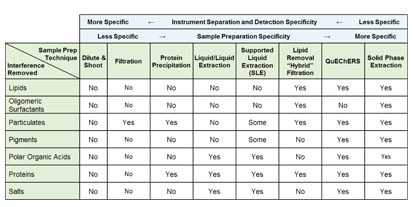
Table 1: Overview of selected sample preparation techniques relative to interferences removed, specificity of technique and instrument selectivity.
There may be instances where applying a more selective technique is insufficient to achieve lower detection limits. By combining more than one sample preparation technique, you may find that you are able to produce a cleaner sample, and thereby improve your detection limits. For example, a sample preparation protocol that looked at veterinary drugs in meats and milk was developed. This protocol involved a simple pre-treatment of the sample, followed by solid-phase extraction using a reversed-phase polymeric SPE protocol for sample cleanup. This approach allowed suitable detection limits to be achieved for most of the target compounds (Table 2). However, for some of the components, the detection limits and precision were unsuitable, and in looking at the extracted sample, it was clear that there were co-extracted lipid components remaining after the sample cleanup procedure (Figure 1a). An additional cleanup step using a product that provides both mechanical filtration as well as chemical functionality to remove lipids resulted in a cleaner final extract (Figure 3b). After completing the secondary cleanup, the recoveries of the method were improved, resulting in better method performance and lower detection limits.
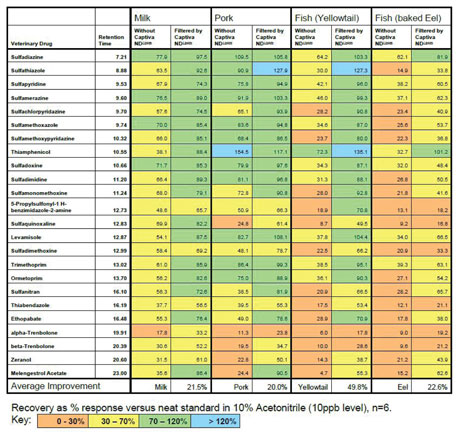
Table 2: Recovery improvements in a sample preparation protocol by using functional filtration step in addition to an SPE method.
A secondary benefit of this additional cleanup step is the removal of the lipid components, which also helps extend the lifetime of the analytical system — a benefit that we will discuss further in the next section.
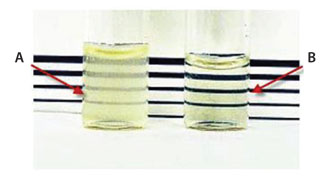
Figure 1: Comparison of sample extract following SPE (A) with sample extract following SPE and Captiva ND Lipid filtration step.
In this example, we show the benefits of combining a liquid/liquid extraction (LLE) with dual-phase SPE. A liquid-liquid extraction of tomatoes and lemons was performed using acetonitrile and a salting-out partition step to achieve a crude extract in acetonitrile (Figure 2a). This acetonitrile extract is suitable for analysis without subsequent cleanup; however, matrix components can affect the method performance. However, sufficient matrix is present that this could affect the analytical performance of the method. A subsequent cleanup step was performed using a dual-phase SPE cartridge that contains graphitized carbon (GCB) and amino (NH2) SPE sorbent material (Figure 2b). By performing this additional cleanup step, the sample extract is visibly cleaner (Figure 2c). Recoveries of the target compounds were maintained, with good precision.
Maximize Analytical Uptime and Minimize Unplanned Maintenance Cycles
One opportunity for combining multiple sample preparation techniques lies in extending the instrument performance. As noted previously, you may find that your results over time are not as good as they were when the system was clean. Perhaps you’re replacing LC or GC columns or cleaning the detector more frequently than you expect, or you find contamination in your system. Peak shapes changed, retention times shifted, responses declined, or all of these symptoms exist at once. Doing additional sample preparation is one means of extending your analytical uptime and addressing these issues.
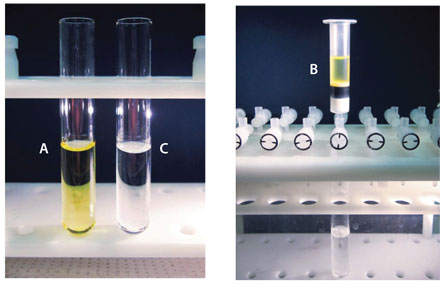
Figure 2: Liquid-liquid extraction plus dual-layer SPE cleanup for the analysis of pesticides in fruit, showing LLE extract (A), dual-layer SPE with sample extraction in progress (B), and final clean extract (C).
One of the simplest means of performing additional sample cleanup is through the addition of a filtration step at the end of your sample preparation cycle. This filtration step can be performed with a syringe filter or other mechanical filter that is designed to remove particulates. Particulates can be problematic particularly in ultra-high-pressure LC systems, with sub-2 µm particle size columns. Using a high-quality syringe filter removes particulates and protects the analytical system while not affecting analyte recoveries. Using the right filter material and selecting a certified clean product also ensures that the filter does not contaminate the sample that you have worked diligently to prepare. Figure 5 shows the increase in backpressure on a sub-2 µm UHPLC column when human plasma was prepared with a simple protein precipitation step using acidified acetonitrile, which was then evaporated and reconstituted in methanol/water (10:90).
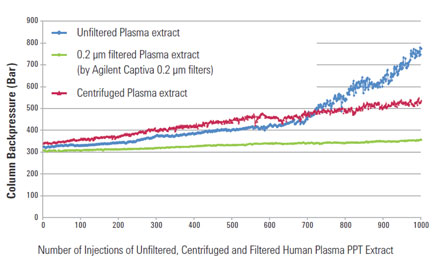
Figure 3: Comparison of backpressure relative to injection number for human plasma extracts, showing results for unfiltered, centrifuged and filtered protein precipitated (PPT) human plasma.
These plasma samples were then analysed in the following manner: 1) without filtration 2) with centrifugation only, no filtration, or 3) with filtration using an Agilent Captiva 0.2 μm filter. Protein precipitation followed by filtration provided longer analytical uptime relative to unfiltered or even centrifuged samples (Figure 3).
Maximizing Your Sample Prep Investment
Clearly, not every situation calls for multiple sample preparation protocols. The examples highlighted here represent a selection of opportunities for how, and why, “mixing and matching” sample preparation techniques should be considered. Numerous other examples are available that demonstrate the utility of combining different approaches and protocols. The QuEChERS (Quick, Easy, Cheap, Effective, Rugged, Safe) approach to sample preparation is a prime example of an integrated approach to mixing and matching sample preparation techniques, namely a liquid/liquid partitioning extraction step followed by a dispersive SPE cleanup step. Sample preparation time and materials are an investment in your analytical success, and doing the right amount of sample preparation relative to your needs and goals is an important balance to achieve. In instances where a single method does not suffice, “mixing and matching” techniques can take your results to the next level of performance.




